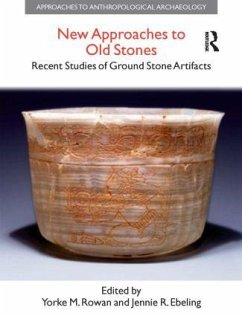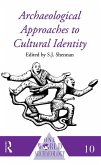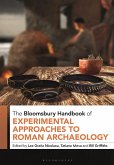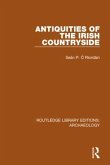- Gebundenes Buch
- Merkliste
- Auf die Merkliste
- Bewerten Bewerten
- Teilen
- Produkt teilen
- Produkterinnerung
- Produkterinnerung
Ground stone artefacts were widely used in food production in prehistory
Andere Kunden interessierten sich auch für
![Computational Approaches to Archaeological Spaces Computational Approaches to Archaeological Spaces]() Computational Approaches to Archaeological Spaces200,99 €
Computational Approaches to Archaeological Spaces200,99 €![Archaeological Approaches to Cultural Identity Archaeological Approaches to Cultural Identity]() Archaeological Approaches to Cultural Identity187,99 €
Archaeological Approaches to Cultural Identity187,99 €![Testing the Hinterland: The Work of the Boeotia Survey (1989-1991) in the Southern Approaches to the City of Thespiai [With CDROM] Testing the Hinterland: The Work of the Boeotia Survey (1989-1991) in the Southern Approaches to the City of Thespiai [With CDROM]]() Anthony SnodgrassTesting the Hinterland: The Work of the Boeotia Survey (1989-1991) in the Southern Approaches to the City of Thespiai [With CDROM]124,99 €
Anthony SnodgrassTesting the Hinterland: The Work of the Boeotia Survey (1989-1991) in the Southern Approaches to the City of Thespiai [With CDROM]124,99 €![History and Approaches to Heritage Studies History and Approaches to Heritage Studies]() History and Approaches to Heritage Studies95,99 €
History and Approaches to Heritage Studies95,99 €![The Bloomsbury Handbook of Experimental Approaches to Roman Archaeology The Bloomsbury Handbook of Experimental Approaches to Roman Archaeology]() The Bloomsbury Handbook of Experimental Approaches to Roman Archaeology183,99 €
The Bloomsbury Handbook of Experimental Approaches to Roman Archaeology183,99 €![Structured Worlds Structured Worlds]() Aubrey CannonStructured Worlds201,99 €
Aubrey CannonStructured Worlds201,99 €![Antiquities of the Irish Countryside Antiquities of the Irish Countryside]() Seán P Ó RíordáinAntiquities of the Irish Countryside180,99 €
Seán P Ó RíordáinAntiquities of the Irish Countryside180,99 €-
-
-
Ground stone artefacts were widely used in food production in prehistory
Hinweis: Dieser Artikel kann nur an eine deutsche Lieferadresse ausgeliefert werden.
Hinweis: Dieser Artikel kann nur an eine deutsche Lieferadresse ausgeliefert werden.
Produktdetails
- Produktdetails
- Verlag: Taylor & Francis
- Seitenzahl: 396
- Erscheinungstermin: 1. November 2005
- Englisch
- Abmessung: 249mm x 178mm x 30mm
- Gewicht: 953g
- ISBN-13: 9781845530440
- ISBN-10: 1845530446
- Artikelnr.: 22021971
- Herstellerkennzeichnung
- Libri GmbH
- Europaallee 1
- 36244 Bad Hersfeld
- gpsr@libri.de
- Verlag: Taylor & Francis
- Seitenzahl: 396
- Erscheinungstermin: 1. November 2005
- Englisch
- Abmessung: 249mm x 178mm x 30mm
- Gewicht: 953g
- ISBN-13: 9781845530440
- ISBN-10: 1845530446
- Artikelnr.: 22021971
- Herstellerkennzeichnung
- Libri GmbH
- Europaallee 1
- 36244 Bad Hersfeld
- gpsr@libri.de
Yorke M. Rowan is Research Associate in the Archaeology of the Southern Levant with the Oriental Institute at the University of Chicago. Jennie R. Ebeling is Associate Professor of Archaeology at the University of Evansville, Indiana.
1: Introduction: The Potential of Ground Stone Studies; I: Production and
Exchange; 2: Geological Constraints on Ground Stone Production and
Consumption in the Southern Levant; 3: Discovery of a Medieval Islamic
Industry for Steatite Cooking Vessels in Egypt's Eastern Desert; 4: Beyond
the Mohs Scale: Raw Material Choice and the Production of Stone Vases in a
Late Minoan Context; 5: Stones on Stone: Assessing the Use of Handstones as
Tools to Process Stone Artifacts at PPNB Ba'ja in Southern Jordan; 6: A
Chip Off the Old Millstone: Grinding Stone Production and Distribution in
the Early Bronze Age of the Negev; 7: The Exchange of Ground Stone Tools
and Vessels during the Early Bronze Age in the Southern Levant; 8: Craft
Production and the Organization of Ground Stone Technologies; 9:
Maize-Grinding Tools in Prehispanic Central Mexico; II: Interpreting
Function, Primary vs. Secondary Use; 10: Grinding Stones and Seeds of
Change: Starch and Phytoliths as Evidence of Plant Food Processing; 11:
Identifying Lightly Used Polishing Stones: Experiments and Implications;
12: Wear Patterns on Ground Stone Implements from Tel Yin'am; 13: Variation
in the Organization of Prehistoric Milling Technologies of the Northern
Mojave Desert, North America; 14: Beyond the Broken; 15: Ground Stone
Tools, Refuse Structure, and the Life Histories of Residential Buildings at
Ayn Ab? Nukhayla, Southern Jordan; 16: The Changing Face of Ground Stone
Studies in the American Great Basin; III: Symbols of Luxury and Ritual
Equipment; 17: Basalt Bowls in EB IA Shaft Tombs at Bab edh-Dhra':
Production, Placement and Symbolism; 18: Stone Alabastra in Western
Anatolia; 19: Carving Luxury: Late Classic White Stone Vase Traditions in
Mesoamerica; 20: Stone Vessel Production Caves on the Eastern Slope of
Mount Scopus, Jerusalem; 21: Beyond Provenance Analysis: The Movement of
Basaltic Artifacts through a Social Landscape; IV: New Insights from Old
Stones; 22: New Insights from Old Stones: A Survey of Ground Stone Studies
Exchange; 2: Geological Constraints on Ground Stone Production and
Consumption in the Southern Levant; 3: Discovery of a Medieval Islamic
Industry for Steatite Cooking Vessels in Egypt's Eastern Desert; 4: Beyond
the Mohs Scale: Raw Material Choice and the Production of Stone Vases in a
Late Minoan Context; 5: Stones on Stone: Assessing the Use of Handstones as
Tools to Process Stone Artifacts at PPNB Ba'ja in Southern Jordan; 6: A
Chip Off the Old Millstone: Grinding Stone Production and Distribution in
the Early Bronze Age of the Negev; 7: The Exchange of Ground Stone Tools
and Vessels during the Early Bronze Age in the Southern Levant; 8: Craft
Production and the Organization of Ground Stone Technologies; 9:
Maize-Grinding Tools in Prehispanic Central Mexico; II: Interpreting
Function, Primary vs. Secondary Use; 10: Grinding Stones and Seeds of
Change: Starch and Phytoliths as Evidence of Plant Food Processing; 11:
Identifying Lightly Used Polishing Stones: Experiments and Implications;
12: Wear Patterns on Ground Stone Implements from Tel Yin'am; 13: Variation
in the Organization of Prehistoric Milling Technologies of the Northern
Mojave Desert, North America; 14: Beyond the Broken; 15: Ground Stone
Tools, Refuse Structure, and the Life Histories of Residential Buildings at
Ayn Ab? Nukhayla, Southern Jordan; 16: The Changing Face of Ground Stone
Studies in the American Great Basin; III: Symbols of Luxury and Ritual
Equipment; 17: Basalt Bowls in EB IA Shaft Tombs at Bab edh-Dhra':
Production, Placement and Symbolism; 18: Stone Alabastra in Western
Anatolia; 19: Carving Luxury: Late Classic White Stone Vase Traditions in
Mesoamerica; 20: Stone Vessel Production Caves on the Eastern Slope of
Mount Scopus, Jerusalem; 21: Beyond Provenance Analysis: The Movement of
Basaltic Artifacts through a Social Landscape; IV: New Insights from Old
Stones; 22: New Insights from Old Stones: A Survey of Ground Stone Studies
1: Introduction: The Potential of Ground Stone Studies; I: Production and
Exchange; 2: Geological Constraints on Ground Stone Production and
Consumption in the Southern Levant; 3: Discovery of a Medieval Islamic
Industry for Steatite Cooking Vessels in Egypt's Eastern Desert; 4: Beyond
the Mohs Scale: Raw Material Choice and the Production of Stone Vases in a
Late Minoan Context; 5: Stones on Stone: Assessing the Use of Handstones as
Tools to Process Stone Artifacts at PPNB Ba'ja in Southern Jordan; 6: A
Chip Off the Old Millstone: Grinding Stone Production and Distribution in
the Early Bronze Age of the Negev; 7: The Exchange of Ground Stone Tools
and Vessels during the Early Bronze Age in the Southern Levant; 8: Craft
Production and the Organization of Ground Stone Technologies; 9:
Maize-Grinding Tools in Prehispanic Central Mexico; II: Interpreting
Function, Primary vs. Secondary Use; 10: Grinding Stones and Seeds of
Change: Starch and Phytoliths as Evidence of Plant Food Processing; 11:
Identifying Lightly Used Polishing Stones: Experiments and Implications;
12: Wear Patterns on Ground Stone Implements from Tel Yin'am; 13: Variation
in the Organization of Prehistoric Milling Technologies of the Northern
Mojave Desert, North America; 14: Beyond the Broken; 15: Ground Stone
Tools, Refuse Structure, and the Life Histories of Residential Buildings at
Ayn Ab? Nukhayla, Southern Jordan; 16: The Changing Face of Ground Stone
Studies in the American Great Basin; III: Symbols of Luxury and Ritual
Equipment; 17: Basalt Bowls in EB IA Shaft Tombs at Bab edh-Dhra':
Production, Placement and Symbolism; 18: Stone Alabastra in Western
Anatolia; 19: Carving Luxury: Late Classic White Stone Vase Traditions in
Mesoamerica; 20: Stone Vessel Production Caves on the Eastern Slope of
Mount Scopus, Jerusalem; 21: Beyond Provenance Analysis: The Movement of
Basaltic Artifacts through a Social Landscape; IV: New Insights from Old
Stones; 22: New Insights from Old Stones: A Survey of Ground Stone Studies
Exchange; 2: Geological Constraints on Ground Stone Production and
Consumption in the Southern Levant; 3: Discovery of a Medieval Islamic
Industry for Steatite Cooking Vessels in Egypt's Eastern Desert; 4: Beyond
the Mohs Scale: Raw Material Choice and the Production of Stone Vases in a
Late Minoan Context; 5: Stones on Stone: Assessing the Use of Handstones as
Tools to Process Stone Artifacts at PPNB Ba'ja in Southern Jordan; 6: A
Chip Off the Old Millstone: Grinding Stone Production and Distribution in
the Early Bronze Age of the Negev; 7: The Exchange of Ground Stone Tools
and Vessels during the Early Bronze Age in the Southern Levant; 8: Craft
Production and the Organization of Ground Stone Technologies; 9:
Maize-Grinding Tools in Prehispanic Central Mexico; II: Interpreting
Function, Primary vs. Secondary Use; 10: Grinding Stones and Seeds of
Change: Starch and Phytoliths as Evidence of Plant Food Processing; 11:
Identifying Lightly Used Polishing Stones: Experiments and Implications;
12: Wear Patterns on Ground Stone Implements from Tel Yin'am; 13: Variation
in the Organization of Prehistoric Milling Technologies of the Northern
Mojave Desert, North America; 14: Beyond the Broken; 15: Ground Stone
Tools, Refuse Structure, and the Life Histories of Residential Buildings at
Ayn Ab? Nukhayla, Southern Jordan; 16: The Changing Face of Ground Stone
Studies in the American Great Basin; III: Symbols of Luxury and Ritual
Equipment; 17: Basalt Bowls in EB IA Shaft Tombs at Bab edh-Dhra':
Production, Placement and Symbolism; 18: Stone Alabastra in Western
Anatolia; 19: Carving Luxury: Late Classic White Stone Vase Traditions in
Mesoamerica; 20: Stone Vessel Production Caves on the Eastern Slope of
Mount Scopus, Jerusalem; 21: Beyond Provenance Analysis: The Movement of
Basaltic Artifacts through a Social Landscape; IV: New Insights from Old
Stones; 22: New Insights from Old Stones: A Survey of Ground Stone Studies




![Testing the Hinterland: The Work of the Boeotia Survey (1989-1991) in the Southern Approaches to the City of Thespiai [With CDROM] Testing the Hinterland: The Work of the Boeotia Survey (1989-1991) in the Southern Approaches to the City of Thespiai [With CDROM]](https://bilder.buecher.de/produkte/21/21846/21846059m.jpg)



